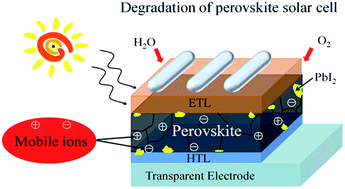The detrimental effect of excess mobile ions in planar CH3NH3PbI3 perovskite solar cells†
Abstract
The origin of the impact of mobile ions in perovskite solar cells (PVSCs) has recently become a hot topic of debate. Here, we investigate systematically the structural effect and various recombination pathways in PVSCs with different ion concentrations. By probing the transient ionic current in PVSCs, we extract mobile ion concentrations in a range of 1016 cm−3 to 1017 cm−3 depending on the processing conditions during a two-step process. The PVSC with the lowest ion concentration has both the highest efficiency over 15% and shelf-life over 1300 hours. Interestingly, in contrast to the commonly adopted models in the literature, we find that the crystal size and the bimolecular and trap-assisted recombination are not responsible for the large difference in photovoltaic performance. Instead, by using transient photocurrent and steady-state photoluminescence approaches, we find that the large reduction of short-circuit current (Jsc) in mobile ion populated devices is ascribed to the slow decay in photocurrent and the increasing amount of non-radiative recombination. In addition, we also find that the excess mobile ions trigger the deformation of perovskite to PbI2, which severely reduces the device lifetime. The results provide valuable information on the understanding of the role of excess mobile ions in the degradation mechanism of PVSCs.


 Please wait while we load your content...
Please wait while we load your content...